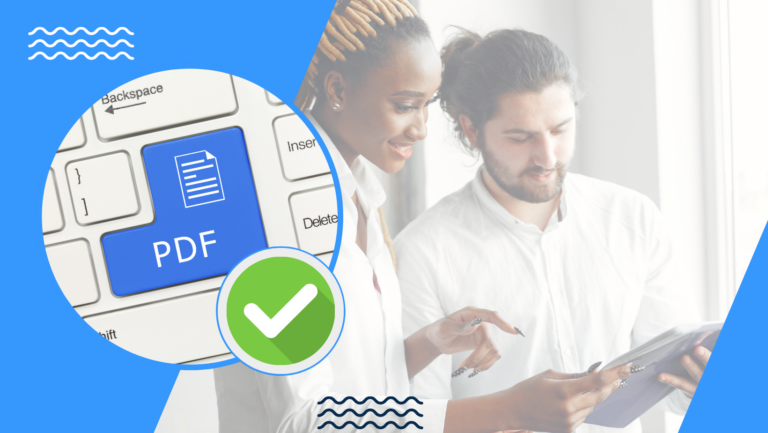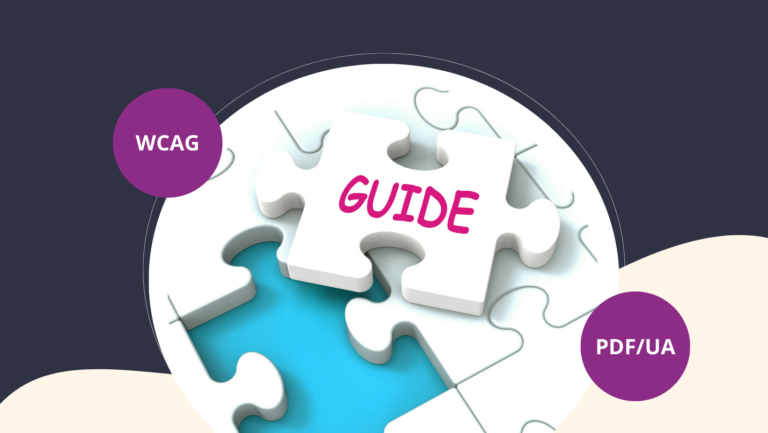In the digital age, it has become essential to be able to offer online content that is accessible to everyone, especially people with disabilities. Many technological advances have taken a significant step forward in digital accessibility, but this is not enough. Indeed, the most commonly used digital format today is the PDF format. This format, while easy and quick to use, has limitations, such as its accessibility.
So what about the PDF/UA standard, which ensures the accessibility of PDF documents for all? We invite you to decrypt the challenges of this standard and its significance for digital accessibility together.
What is the PDF/UA standard?
Presentation of the standard
What does ‘PDF/UA’ mean?
The acronym UA stands for ‘Universal Accessibility’. Therefore, the name ‘PDF/UA’ refers to the method of making a PDF readable by assistive technologies so that a computer can read the document’s content aloud. It is about making the DF format universally accessible, regardless of disabilities: visual, auditory, cognitive, and more.
Creation of the PDF /UA Standard
PDF is the format we prefer to use in our daily lives for reading and exchanging documents. Widely used in the professional world, it is a format that ensures security and compatibility with all systems, allowing text and non-textual elements to remain intact. However, PDF documents are not accessible to everyone, especially people with disabilities.
It is in this context that the PDF/UA standard comes into play, published in July 2012 under the reference ISO 14289.
The PDF/UA standard (PDF for Universal Access) offers numerous advantages and was created to ensure easy and equal accessibility to PDFs for everyone. It is also supported by the PDF Association. Founded in 2006, the PDF Association promotes the adoption and implementation of international standards for PDF document accessibility. It collaborates with ISO working groups, particularly in the development of PDF standards.
Another existing standard: PDF/A
Not to be confused with the PDF/UA standard, the PDF/A standard was introduced well before the year 2012. It emerged in 2005, and PDF/A is an ISO standard designed to meet the needs of long-term document archiving.
The advantage of the PDF/A standard is that it allows files to remain true to the original documents: fonts, images, graphical elements, and the formatting of the original document are preserved, regardless of the platforms used.
The main characteristic that sets the PDF/A standard apart is that it prohibits any elements unsuitable for long-term archiving, such as hyperlinks, animations, .exe files, or JavaScript. As a result, these documents can be preserved for very long periods without issues.
While the PDF/A standard enables long-term preservation of documents, it does not, however, make PDF documents accessible to everyone. This is why the PDF/UA standard was created and is essential in digital accessibility.
The standard for accessible PDFs
What makes PDF documents not accessible?
Generally, PDF files are not accessible when they cannot be interpreted by a screen reader, and the reading order is not defined.
Here are some examples of types of non-accessible PDF documents:
- Image PDFs: Some PDF documents actually contain printed pages that have been scanned. It is, therefore, impossible to select the content of the document and perform a text search within it. Users with visual impairments will not be able to use the document effectively.
- Protected documents: In this type of documents, it is impossible to copy/paste elements. Moreover, the content is sometimes not readable by screen reader software or in Braille. This is because automatic accessibility is not allowed, especially for confidential content.
- Unstructured documents: Most of the PDF documents found online or shared with us are often not tagged.
As mentioned earlier, the tagging step is essential for proper reading order. The major issue with such untagged documents is the disorderly presentation of content.
In conclusion, when a person uses a screen reader to navigate and encounters non-accessible PDF documents (such as those mentioned above), the process can become lengthy and quickly discouraging for them. This is why offering PDFs that are universally accessible to everyone is a crucial challenge.
Complying with the PDF/UA standard
How to do it?
In order to create a document that is accessible to all, every author must ensure to adhere to several criteria dictated by the PDF/UA standard. Here are some of these criteria:
Providing semantic structure
The content of the PDF document is divided into 2 categories:
- Significant content: includes paragraphs, headings, and levels of headings…
- Artifacts (or decorative content): This category includes all graphical objects, header or footer information, lines or graphics separating sections of a page, decorative images…
Significant content and artifacts must each be marked with respective tags and create a complete hierarchy.
Defining logical reading orders
The hierarchy created by the tags indicates the reading order of a PDF (pr ‘logical order’):
“7.1 Overall, […] the content must be included in the hierarchy with appropriate semantic tags arranged in the logical reading order..” Excerpt from the PDF/UA 1.0 standard
Defining a reading order is crucial for a document to be accessible. Blind and visually impaired individuals use screen readers. Therefore, when the content of a PDF file is not tagged, screen readers may transcribe a reading order that is not always logical and understandable.
Including alternative texts
Alternative text plays a crucial role in the accessibility of PDF documents. It serves to:
- Make the content or function of the image accessible to users with visual or cognitive impairments. Screen readers announce the alternative text instead of the image.
- Display text when certain browsers do not support images or when the image is not available.
- Add descriptions to images that can be read by search engines or used to determine the image’s content from its context.
How to measure the accessibility level of your PDF document?
The PDF Accessibility Checker (PAC) tool allows you to check the compliance of the 108 applicable criteria in the document and thus validate the PDF/UA standard.
Its first version dates back to 2010, and the tool is now available in 5 languages (Danish, English, French, German, Spanish).
Discover how the tool works and what its limitations are in this article.
Engaging experts to comply with the PDF/UA standard
To make PDFs accessible, it is possible to engage teams trained and specialized in digital accessibility.
We have developed an AI solution called ‘PDF Accessible’ that helps meet the requirements of the PDF/UA standard.
The PDF Accessible tool
What is the PDF Accessible tool? How does it work?
PDF tagging is a service we have been providing since 2007. Each year, our teams process over 100,000 pages to tag and make the contents of PDFs accessible. Whether it’s text, images, diagrams, or tables, our methodology ensures compliance with the PDF/UA standard.
PDF Accessible is an AI solution capable of analyzing and tagging communication and financial documents in PDF format according to the PDF/UA standard without any prerequisites.
We are able to detect key elements (heading, paragraphs, images, tables, charts, footnotes, email addresses, reading order, etc.) and transcribe them independently of the layout or written information.
Who is the PDF Accessible solution intended for?
Our solution is aimed at public or private organizations for whom societal and legal issues, as well as inclusive projects, are pillars of their CSR (Corporate Social Responsibility) strategy.
Communication agencies are also affected because consultations and tenders increasingly include clauses related to compliance with the ISO 14289 accessibility standard. Furthermore, since Decree No.2019-768 of July 24, 2019, the legislator in France imposes accessibility for eligible organizations, including the accessibility of office files, including PDFs.
To go further, our online solution
PDF Accessible is available as an online platform or Software as a Service (SaaS) to provide you with complete autonomy in managing your publications.
Our solution is simple and fast:
- Upload your pdf on our saas
- Start the processing
- Retrieve your tagged pdf












